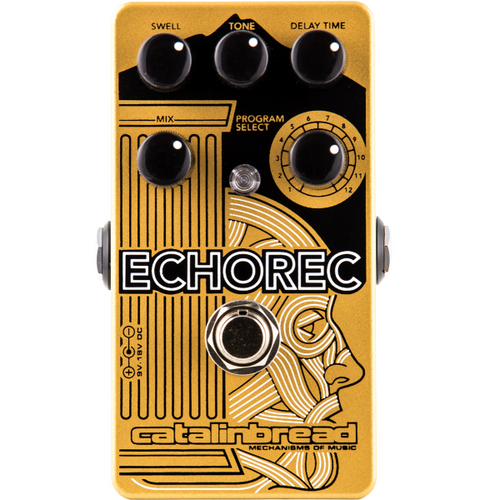Big wet and splashy. 60’s outboard spring reverb tank.
OVERVIEW
The goal was simple; make a reverb pedal that functions just like a real deal outboard spring reverb unit. Catalinbread felt that adding more knobs for the sake of adding knobs would take away from the experience, so we kept it down to the controls that were on the actual units. They only added or extended controls that contributed to the experience in a positive way. The DWELL knob controls how much signal is going into and driving reverb springs. As on the original unit, cranking this knob up can cause clipping on the wet side due to the signal crashing the springs. Though it seems to imply reverb length (and sort of functions this way), this control is quite literally a volume knob for the springs.
The TONE knob allows you to roll off just the right amount of high end from only your wet signal. Roll this knob back if you want the reverb to appear to more distant and out of the way of your dry sound.
Catalinbread took liberties with the MIX knob extending beyond the original reverb tank units because they wanted you to be able to make the Topanga 100% wet. Otherwise it is much like the knob on the tanks, allows you to balance between your wet and dry signals.
Original spring tank units had a big feel to them that encourage a lot of attitude from the musician playing through them. Catalinbread asked themselves, "how can we make the Topanga even bigger sounding?!" The only answer to that question was add a VOLUME knob that pushes the entire circuit! This is a modification that we have actually performed on the big tube tank units!
EXPERIENCE
Being an old school effect, tank reverb units were invented before effects loops etc. Had the Topanga been invented before the spring tank units, players would have put the pedal in front of their amplifiers and as close to the front of their pedal boards. You should look at your Topanga as a sort of "pre-reverb" type pedal, putting only fuzz boxes in front of it allowing splash, crash, and drench everything downstream. If you have any experience with original tank units, you won’t have any problems finding your way around the Topanga. If you do not have much experience and/or if you simply want to enrich your experience with your Topanga, please check out the manual!
THE STORY FROM CATALINBREAD
"The outboard Fender 6G15 spring reverb unit is the sound of Surf guitar, Spaghetti Western and many other great guitar sounds from the sixties. Part of its magic, and how it differs from the internal spring reverb found in most Fender-style amps, is that it is run in front of the amp, causing the reverb signal to distort and sound more intense. Because there were additional knobs on the outboard units, you also have more control over the reverb qualities. The Dwell knob controlled how hard the springs were getting hit by the guitar signal. The Tone knob allowed the treble to be dialed back to just the right degree of brightness. It was also essentially a tube preamp, so it would color the sound going into the amp. All this added up to a very distinctive reverb sound with a lot of attitude and complex non-linearities that are hard to replicate. But we here at Catalinbread did just that! Besides giving you the classic three knob control compliment of the original, we’ve also added a great discrete preamp that you can control via the Volume knob for a healthy amount of great clean boost when you want it."













